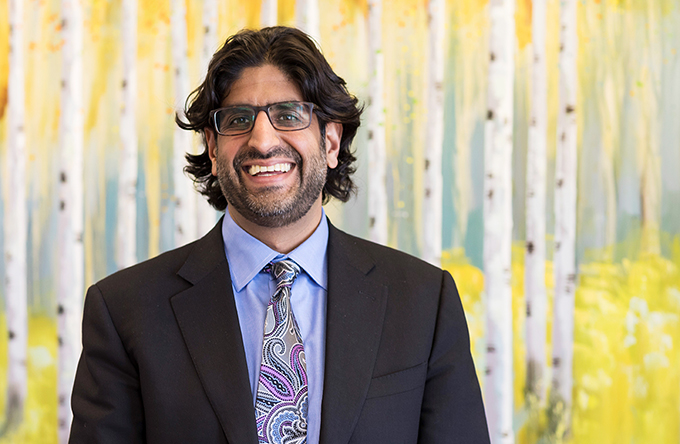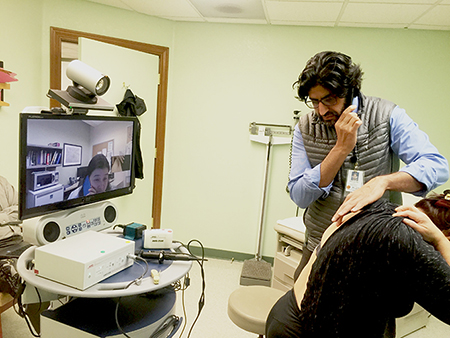Five Permanente Medical Groups earn recognition from the AMA for initiatives in physician wellness and burnout reduction.

Rahul Rastogi, MD, is chief operating officer of Northwest Permanente. He is committed to innovation to bring quality, convenient care to Kaiser Permanente members.
Right Care, Right Time, Right Place
Rahul Rastogi, MD, Committed to Finding Innovative Ways to Deliver Quality Care
By Athan Bezaitis
The Permanente Federation
At Kaiser Permanente, we continue to be thoughtful about our commitment to getting every member the right care, at the right time, in the right place. Thanks to the ingenuity of Rahul Rastogi, MD, the chief operating officer of Northwest Permanente (NWP), “right place” is taking on a whole new meaning.
With his creative approach to better access, Kaiser Permanente’s Northwest Region is becoming a model not just for the rest of the organization but the entire U.S. health care system. It recently opened an urban neighborhood clinic in Portland, Oregon, and is experimenting with a variety of virtual visits.
Dr. Rastogi began his career practicing emergency medicine, a field well-suited to his personality. “No day is ever the same in the ER, and I enjoy the unexpected,” he explains.
Little did he know this mindset would serve him well in his future. Dr. Rastogi did not go into medicine with leadership ambitions, but as he worked as a doctor at Kaiser Permanente, he was inspired to make the organization even better.
With years of practice under his belt, an eye for creativity, an interest in system design, leadership coursework, and a willingness to embrace the unexpected, he was naturally suited to the position of COO.
Balancing Many Demands
“Being a COO is a lot like being an ER physician,” Dr. Rastogi says. “You need to know a little bit about a lot of things – most importantly when to pull in the specialists.”
That philosophy served him well when balancing member growth, physician recruitment to meet demand, and interest from the community for more convenient access to care.
Like other regions, the Northwest has recently experienced significant enrollment growth – last year the region grew 4.5 percent and added nearly 24,000 members – causing Kaiser Permanente leadership to take a close look at what members and the community needed most. They came up with the concept for Care Essentials, the organization’s first neighborhood-based convenient care clinic.
Now open to members and non-members, the clinic provides same-day, convenient access to care in a heavily populated urban neighborhood of Portland.
Being a COO is a lot like being an ER physician. You need to know a little bit about a lot of things – most importantly when to pull in the specialists.
The concept of a “minute clinic” isn’t new, “but one that is ‘uniquely KP’ is a novel idea,” Dr. Rastogi says. Unlike other clinics of its kind, Care Essentials offers virtual consults with NWP specialists, access to the organization’s HealthConnect electronic health records system, and connections to the larger Kaiser Permanente system for referrals.
“It is a small clinic with much more power than others like it,” Dr. Rastogi explains. He adds, “The clinic is a great opportunity for non-members to experience, and then consider Kaiser Permanente.”
Over time, as the region adds more convenient care clinics, they will become part of a broader Kaiser Permanente strategy to help improve access to convenient care, especially where geography or real estate is not conducive to a large clinic footprint.
Expanding Use of Virtual Visits
Dr. Rastogi has pioneered innovation in several other areas, too. Captivated by the work of radiologists who can read films and assist patients from almost anywhere in the world, he realized this could be a model brought to multiple disciplines in medicine.

Once you consider that the physician doesn’t always need to be in the same room as the patient, he says, there are endless possibilities to innovate new models of care delivery. Patients want convenient access to care – specifically, virtual visits. According to a recent Accenture poll, over three quarters of patients are interested in receiving virtual health care visits.
Dr. Rastogi saw the need and the possibilities. Today 18 percent of the Northwest’s 567,000 members are seen virtually – either by phone or video with a provider. Kaiser Permanente’s Colorado Region has led similar innovations in virtual visits, and today the two regions exchange best practices.
Dr. Rastogi’s goal is to eventually increase this number to 50 percent, explaining that just one physician offering virtual visits saves the organization multiple same-day appointments. In a system with a growing number of members, that makes perfect sense and is equally convenient for patients, who can avoid taking time off work and commuting to and from their appointments.
Dr. Rastogi says the majority of phone and video visits meet most patients’ needs. Looking toward the future, he is exploring the idea of linking visits of this kind with all of Kaiser Permanente’s regions. That would bring the Mid-Atlantic, Georgia, Colorado, Northern and Southern California, Northwest, Seattle, and Hawaii regions together to someday provide a 24/7 virtual environment across all time zones – meaning a patient in Honolulu could see a doctor in Portland.
E-visits for Common Care
E-visits are another creative strategy to enhance access and convenience. Dr. Rastogi and team have once again partnered with Colorado in an endeavor that will ultimately allow patients to complete a series of questions online when they have any one of several basic medical concerns. Software will ask them a series of guided, web-based questions about their medical symptoms and history such as, do you have a fever? Sore throat?
After submitting their answers, a Kaiser Permanente advice telehealth nurse will then review the information, consult with a physician as needed, and ideally respond within 60 minutes to provide a diagnosis and care plan, including any necessary prescriptions. That saves the patient a trip to the doctor’s office and allows the physician more time to treat patients with more complicated conditions.
“With a rising sense of urgency around the future provider shortage, we need to both recruit and retain more physicians and nurses, and clinician burnout is a big concern, too,” says Dr. Rastogi. “But to borrow the words of Imelda Dacones, CEO of Northwest Permanente, ‘We can re-engineer, re-imagine, and re-invigorate how we deliver care to meet these challenges.’ ”
Dr. Rastogi has already been a leader in doing all three.


